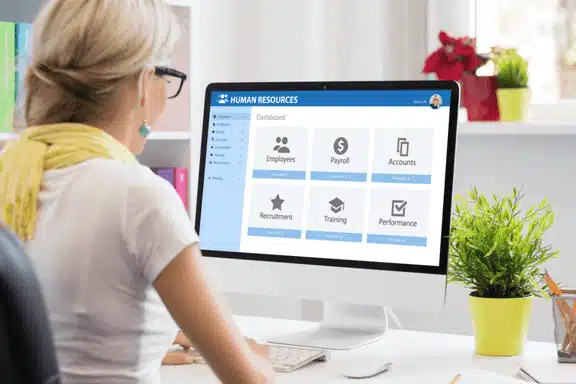HR Management System: Everything You Need to Know
Updated 1st April 2025 | 20 min read Published 12th April 2024

1. What is a Human Resource Management System (HRMS)
A Human Resource Management System (HRMS) is a combination of systems and processes. It combines routine and strategic HR tasks into one comprehensive solution.
Organizations use the HRMS suite of software applications to manage human resources and related processes throughout the lifecycle of their employees.
They typically use HRMS for these functions:
- Candidate recruiting
- Payroll management
- Leave approval
- Attendance tracking
- Succession planning
- Career progression
- Performance reviews
- Overall maintenance of employee information
HR leaders and staff are the primary users of HRMS. That’s because they run day-to-day workforce operations. They are also responsible for reporting on the performance of employees. And they must ensure compliance with applicable laws and regulations.
Other employees may also use an HRMS for self-service HR functions.
HRMS integration with finance and accounting systems is valuable because HR-related costs are among the biggest expenses for companies.
2. HRIS vs HCM vs HRMS
You may be confused by three acronyms people use to describe human resource systems: HRIS, HRMS, and HCM.
The confusion arises because the three acronyms have changed over several decades to mean slightly different things. Over the years, software for human resources has become more comprehensive in its scope and capabilities.
Vendors changed the names of the product categories to differentiate their products from earlier ones. First came HRIS, then HRMS, then HCM.
Today the distinctions are likely to matter more to software vendors than to the companies that buy their products. Some software vendors argue over small nuances.
Let’s start with the oldest of the three HR systems, the HRIS.
What is HRIS?
A Human Resource Information System (HRIS) tracks numerical data and employee information such as an employee’s schedule or social security number (SSN).
The name harkens to the ‘80s, when information technology (IT) departments were called Management Information Systems (MIS).
Besides managing HR data, an HRIS helps HR teams manage policies, procedures, and people. It typically includes these functions:
- Training and development
- Recruiting Attendance
- Compensation
- Benefits administration
- Reporting
- Workflow
- Some accounting
HRIS is a subset of its successor, HRMS.
What is HRMS?
An HRMS typically includes the same information as an HRIS, plus non-quantitative information related to employees and applicants.
Beyond the capabilities of HRIS, HRMS features include onboarding, employee satisfaction, job performance, analytics, payroll, time and labor management, profitability, and more.
What is an HCM system?
Human Capital Management (HCM) is the broadest and most recent of the three acronyms. It refers to information systems that enable companies to manage their human capital.
It includes all elements of an HRMS, but it adds talent management and global capabilities. The global capabilities include multiple languages and currencies, different formatting for specific countries, and maybe localization. Localization may include compliance with local laws and regulations.
3. Why Your Company Needs an HRMS
Your company could benefit from an HRMS in these situations:
Your HR department is overworked. They don’t do everything for which they’re responsible.
Your company is paying money because of compliance errors.
Your company or your employees are spread out over multiple locations. You have no platform to see HR data across your locations. Employees find it hard to connect with their direct supervisor.
You have few effective ways to engage with employees.
Employee turnover is high, and you aren’t sure why.
HRMS suites offer these benefits:
- They gather and maintain all workforce information in a central repository.
- Your executives can see workforce trends and their implications. They can generate accurate reports that combine financial and HR data. They can fully understand your workforce. They can accurately calculate labor costs and keep revenue per employee in line.
- You can automate many routine, time-consuming HR tasks such as providing employees with information on their pay history. This enables your HR team to focus on more strategic issues, including recruiting and retention.
- You can empower managers and employees to serve themselves for common HR functions. This is an important selling point for younger hires.
- You can stay compliant with changing tax laws and labor regulations.
Further, you don’t have to buy, integrate, and maintain separate software products for diverse HR functions.
Essential Features of an HRMS
This is your high-level guide to the capabilities of HRMS.
1. Employee Database
Your employees may be spread all over the map. Having all their data in a single place improves your ability to manage and serve them.
Data in a central place is easier to maintain and update. You can keep it more accurate. Better data enables faster, more confident decision making.
Centralized employee data is also essential for workforce planning and analytics. It enables you to assess your current workforce and plan for future needs.
Among other things, you can identify and address gaps in workforce skills. And you can develop succession plans.
2. Recruitment and Onboarding
With HRMS, you can attract top talent and build your company’s reputation as the place everyone wants to work.

You can automate the process of preparing job requisitions and posting notifications to online job boards.
You can also improve the experience of candidates interested in working at your company.
HRMS connects recruiters and potential job candidates in an easy, timely two-way flow of information.
Once a candidate has accepted your job offer, an HRMS can automate and accelerate the process of sharing notifications and executing agreements and forms.
3. Timesheets and attendance management
With timesheets and attendance management, employees record their actual labor hours. You use the data for billing, payroll, or operations.
Time theft is a common problem. In one study, half of the employees admitted to it. Sixteen percent said they had punched a clock for a friend. In another study, 43% of respondents admitted they had exaggerated the hours they’d worked.
Time tracking software helps you curb such theft.
It captures the time employees actually spend on assigned tasks. The system then shares this information for use in automating payroll or invoicing clients.
You can use the data to expose which tasks consume the most staff time and cost the most money. With this information, managers can plan project budgets and avoid cost overruns.
Time tracking software typically includes these added capabilities:
- Online timesheet
- Project management
- Online invoicing
- Alerts
- User management
- Reporting and analytics
4. Payroll Management
Payroll management software helps employers manage and automate the administration of their payroll processes.
It also helps employers stay compliant with state, local, and federal rules and regulations related to payroll processing and taxation. Such rules and regulations vary widely, and they change often.
5. Performance Management
Performance management software enable organizations to do these things:
- Work with employees to performance goals for their individual work
- Measure employees’ progress toward achieving their goals
- Enable employees to assess their progress
- Provide feedback and coaching to employees
6. Employee Benefits Administration
Employee benefits administration software helps organizations in two main ways:
- It helps employers plan and administers employee benefits packages.
- It helps ensure employer compliance with government regulations.
Many benefits administration systems provide employee self-service portals. Through such portals, employees can update their data related to benefits options, beneficiaries, and more.
Employees can also find answers to common questions. They can communicate efficiently and confidentially with benefits administrators.
7. Analytics and Reporting
A full-featured HRMS typically includes reports that provide instant access to important metrics through the Web. You can make faster decisions, with confidence the data is current and accurate.
With such access, managers can:
- See a top-down view of employees’ daily labor activities to identify areas for improvement.
- Spot trends that could improve or harm performance
- Identify inefficiencies and suggest measures to reduce cost or increase throughput
The HRMS platform may pull data from many sources, including these and many more:
- Time tracking systems
- Managers’ new hire applications
- Employee database files
Benefits of an HRMS
HRMS systems offer many benefits that enable companies to achieve fast payback and high return on the investment. Here are six of the top ones.
4Improves Internal Communication
5Easy to Implement Process/Policy Change
1. Minimizes Manual Paperwork
Most current HRMS systems are accessible through mobile devices. The capability puts information and processes in easy, convenient reach of employees and managers.

Among other benefits, it eliminates paperwork and keeps a record of exchanges. Managers and supervisors can schedule automated reminders and emails. HR staff and employees can acknowledge messages and respond fast. Managers save time by not having to chase responses.
2. Improving HR productivity
Remote access to HRMS enables employees to handle some clerical HR tasks on their own. They gain control over their data by securely entering or maintaining it themselves.
Such employee self service frees up time for HR professionals to do other things.
HR professionals can spend as much as 40% of their time each week responding to inquiries or managing big programs such as benefits enrollment or performance reviews.
They can set up a resource in an HRMS where employees find answers to frequently asked questions.
Some HR processes require multiple levels of approval. Examples include:
01
processing timecards
02
job requisitions
03
and
time-off requests
HRMS can provide workflows to automate approvals so managers receive notice to act on a request for approval. The capability can reduce processing time by more than 50%.
3. Lower Operational Costs
A centralized HRMS—especially if it’s deployed in a cloud-based form— is generally less expensive to license and operate than software operated on premises.
That’s because you needn’t buy and maintain your own computer hardware and operating systems. You needn’t rent a data center.
You avoid the costs of IT and development staff resources for maintenance, support, and training.
4. Improves Internal Communication
Lack of communication with employees is a major reason why employees leave an organization. So say several studies conducted over many years. They suggest that better communication reduces the high costs associated with employee turnover.
An HRMS helps by enabling your HR team to share information in real time across your organization. They and other authorized managers can also share information with select segments of your company.
Managers, supervisors, and team leaders in non-HR roles can also send notifications. For example, they can suggest quick meetings or one-on-one discussions. They can send long or short messages. And they can receive time-stamped notification when their message is received. They can do all this without using email.
One advantage of communication through HRMS over email is that it’s more tightly controlled. It’s also not at risk of being lost in an email inbox.
New social HRMS capabilities enable newer forms of both internal and external communications.
External social HRMS extends the reach of your HR team to social channels such as LinkedIn, Twitter, Facebook, Instagram, and others. Engagement in these channels enables employees to help with HR activities such as recruiting new candidates from among friends and colleagues.
Internal social HRMS enables collaboration and easy impromptu sharing of information and insights within your company. If you’re a member of a globally dispersed team, social HRMS helps you exchange information from employees you don’t know personally.
Do you want to talk about an employee trend? Or gather ideas for a position that’s hard to fill? Post a message to a discussion area in your social HRMS.
These capabilities and others enable your company to build a culture of communication with and among employees. By helping bridge gaps between management and other employees, HRMS can help reduce the high cost of employee turnover.
5. Easy to Implement Process/Policy Change
Companies change constantly. They grow. They scale back. They acquire. They are acquired. They change strategic direction. They outsource some operations and insource others. They expand in new geographies and contract in others.

Policies, processes, and procedures evolve. Laws and regulations are revised. Employee benefits come and go.
All of these changes are hard for companies to manage without an HRMS. The bigger the company, the harder it is to manage them without HRMS.
An HRMS system enables HR organizations to navigate such changes in these ways:
- By providing decision makers and planners with accurate, accessible and timely data, information, and insights
- By providing efficient channels to communicate changes to managers and employees
- By providing a framework to execute the changes through performance management
- By executing changes consistently, in compliance with laws and regulations
- By enabling executives to measure progress and the consequences of change through reporting and analytics
6. Security and Data Recovery
Information stored in an HRMS is highly sensitive. It includes proprietary company data and volumes of personal information about employees.

Companies must choose an HRMS that transmits information securely, such as an SSL (secure sockets layer) that encrypts data as it travels over the internet.
Internal security is also crucial. Sensitive Information should be guarded by passwords that have varying levels of access in relation to what is needed for the job position.
Most companies now allow employees access to portions of their HRMS. Employees must understand the importance of maintaining the integrity of the system and protecting the security of the information it contains.
An HRMS comes with built-in security. The security includes authentication measures that protect company data and restrict access to authorized users.
Your HRMS systems are likely to be mission critical for your company. You can’t operate for long if your payroll systems go down. So be sure both your data and your access to your systems are fully recoverable.
The best methods for ensuring recoverability will depend on the way you’ve deployed your system and how fast you must be able to recover it.
How to Choose the Right HRMS for Your Organization
In this section, you’ll learn how to choose a workforce management system through these steps
1. Define Your HR Management Needs
Before a company chooses an HRMS, it is important for your management team to identify your goals, processes, and needs. Consider all for both the long and short term.
Deeply involve your HR professionals in this process. Depending on the size and structure of your company, you may call an organization-wide meeting. Or you may choose representatives from each department to discuss HRMS goals and options.
2. Set a Budget
Establish whose budgets will pay for the project.
Determine how much you’re willing to pay for these elements:
- Software licenses
- Implementation costs, including software configuration, data preparation and transfer, integration, training, and change management
- Operating costs, including IT staffing, computer hardware and software, maintenance of software and data integrations, support services, data centers, and the like.
3. Shortlist Vendors Based on Your Requirements and Budget
Check software-selection sites for third-party reviews. Also ask colleagues for recommendations. Research your alternatives online.
Come up with a manageable list of three to six products or vendors you can evaluate in depth.
4. Collect More Information About Each Vendor You Have Selected
Visit the websites of vendors you’ve shortlisted. Speak with their sales people or consulting staff to learn more about their offerings.
5. Conduct the Demo
For a software application as full-featured as TMS, you may need more than one product demonstration.
That’s because the various people on your selection committee will look for different things, and they may be available for demos at different times.
Prepare your list in advance of the capabilities you want to see in a demo. Involve your stakeholders in preparing the list.
Cooperate with your vendor’s demo team to help them provide a session that’s worth your time.
Make sure the vendor’s demo team shows you everything you want to see. Ask them to go through all the processes that are important to your business.
See if the vendor can customize the demo to your industry and maybe even your company. If you provide a sample of your data for the vendor to load before the demo, your demo is more likely to make sense to your team.
6. Talk to Your Stakeholders and Make a Purchase Decision
Apply the weighted decision criteria from your matrix, giving a numerical score to each product and vendor.
Narrow your list to two or three viable products and vendors.
List your remaining questions and concerns for these vendors.
As you resolve your questions and concerns, begin discussing final agreements.
Steps to Implement an HRMS
The process of implementing a workforce management system includes these steps
1. Involve Key Stakeholders in the Software Adoption Process
Assign a team of people responsible for the implementation of your WFMS. Include appropriate participants from IT, HR, and the various business functions or units whose operations the system will affect.

With your team of stakeholders, determine the amount of change the implementation will involve for each business function or unit. Assess whether you’re likely to need help with change management processes.
Work with your chosen software vendor and other chosen service providers to plan a step-by-step implementation process. Establish timelines. Designate resources. Seek permission from the managers of people you want on your project team.
2. Hire an HRMS Consultant if Needed
Before you implement HRMS software, you’ll want to have appropriate HR policies and processes in place.
Establishing those elements can be a big job in itself, and it may take months.
To help guide your process, you may find it worthwhile to hire a consultant who specializes in such work.
3. Migrate Your Existing Data
You may hear the terms data migration and data conversion used interchangeably. But they are distinctly different processes.
Data migration is moving data from one system to another. If your old and new system contain exactly the same data fields, you can simply migrate your data. But most often, the data fields in the two systems are different. That means you must convert or transform your current HR data to meet the requirements of your new system.
Migration of current data involves these steps:
- Evaluate your data for accuracy and completeness. Cleanse your data as may be necessary.
- Map the fields of your current data to your new system. Evaluate data definitions in both the current and new systems. Plan to convert your current data to any definitions that are different in your new system.
- For fields in your new system that don’t correspond to data in your current system, plan how you’ll gather and enter the new data.
- Load the edited data into your new system.
4. Conduct Internal Testing
Before making your new system generally available to users, conduct internal testing with a small, select team of people who understand your system and your data.
- Conduct system configuration testing. Does the system present all data fields in the expected locations and formats? Are workflows configured properly?
- Test your data accuracy after the migration.
- Test your reports and analytics.
- Conduct user acceptance testing. From a user’s perspective, does the system work as it should? How usable is it? How much time does it take for users to complete key tasks?
Few things are as likely to compromise a successful system implementation as a poor data migration. Users will soon stop trusting the system, and they may refuse to use it.
5. Provide Training and Support
Decide who will need training and how you will support your users.

Will your company provide Level One (or first-level) support, with the option to escalate issues to the software vendor? Or will your vendor provide Level One support?
Decide what kind of training you will provide and where you’ll provide it. Will training occur in a classroom? Will it be online, delivered remotely?
Decide who will conduct the training. Will you do it internally? Will your software vendor train your trainers to train end users?
Frequently Asked Questions
This section addresses five common questions about workforce management systems
1. How Much Does a HRMS Software Cost?
It’s hard to answer this question briefly and accurately.
Some vendors provide transparent pricing information on their websites. Others provide only custom quotations. They do so because software requirements tend to vary from one company to another.
Software vendors typically license and price software in two broad ways:
- Subscription plans for cloud applications (software as a service or SaaS)
- Perpetual licenses for software operated on your premises
Subscription plans
When a software vendor hosts the application on their servers, your company typically pays a monthly or annual subscription fee.
The standard pricing structure is per employee per month. This is usually based on the number of your active employees.
Some vendors charge per user per month. This means you pay for your administrative users (e.g. HR) to use the system. If employee self-service is included as a feature, the vendor may classify employees as users.
Published fees vary widely. You can research them online through third-party software directories such as G2, Capterra, and others.
Perpetual licenses
With perpetual licensing, you host the software application and data on your own servers. You pay for the software once upfront.
You may also pay a recurring cost, such as maintenance or support. You typically pay these fees annually.
The perpetual license fee varies based on the number of employees or users.
Some software modules or features may not be included in the base price. Some vendors may offer specific modules or features as add-ons, such as performance management, payroll, or time and attendance. With such pricing, you pay only for the modules you need.
In addition to software license or SaaS fees, your budget should also include money for these costs:
- Implementation
- Training
- Support
- Consulting
2. Who Is Responsible for Building and Implementing a HRMS Software?
Responsibility for building HRMS software depends on whether you buy it or build it in house.
If you build the software in house, the responsibility is likely to fall to your information technology (IT) organization and your human resources department.
If you build the software in house, the same groups are likely to be responsible for its implementation.
If you license the software from a vendor, the vendor is likely to assume some responsibility for implementation—possibly in cooperation with a business partner.
Your HR department and IT department are always likely to be involved to varying degrees in implementation.
3. Will the HRMS be able to Grow and Scale with My Company?
This question about your company’s growth raises two issues: flexibility and scalability.
Flexibility refers to an HRMS’s ability to adapt to changes as your company grows. These are the changes discussed in a preceding section. They include such moves as mergers and acquisitions, outsourcing, downsizing, new operations, closing of old operations, new lines of business, and more.
So pertinent questions about flexibility include these:
- How easily can you reconfigure or modify the software as your business changes?
- If you modify or reconfigure your HMRS, how might it prevent you from upgrading it in the future?
- How easily can you create and maintain integrations to your other systems?
- How fast can you make the changes you want? How much will it cost?
Scalability, in contrast, refers to the ability of a system to process higher volumes of work. The processing throughput of a system depends on both hardware and software.
Here are more questions to ask regarding flexibility and scalability:
- What are your company’s broad plans for the future: expansion, diversification, consolidation, acquisition?
- How might your HRMS support your company in achieving those future strategic goals?
4. Should I Choose Cloud-Based Software?
You can choose HR Management Software delivered through either of two business models:
- Software based in the cloud (that is, software as a service or SaaS)
- Software you operate on your premises
Each alternative has pros and cons.
In one survey, about three-fourths of respondents chose a web-based or cloud-based system over one deployed on premises.
Cloud-based systems have become more common across most kinds of software applications.
For small businesses that lack IT staff or infrastructure to support on-premises deployment, cloud-based systems offer many advantages.
Even so, cloud-based systems have some disadvantages. They may offer less customization or custom configuration to the needs of a company. They offer less control over back-end infrastructure.
But it’s a myth that cloud-based applications are less secure than on-premises systems. Many cloud systems are more secure than on-premises systems because cloud providers often invest more heavily in security.
Human Resource Management is a key process for any company with more than a few employees. The bigger your company, the bigger your HR challenges are likely to be.
The complexity of HR management poses special challenges for growing companies with more than 10 employees. Such firms often lack the administrative staff and infrastructure to stay ahead of the changes in their business. And they’re reluctant to increase their administrative headcount.
These companies are often good candidates for HRMS.




